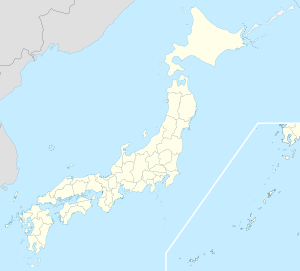Okuyoshino pumped storage power plant
| Okuyoshino pumped storage power plant | ||
|---|---|---|
| Asahi lower basin with inlet structure to the power plant | ||
| location | ||
|
|
||
| Coordinates | 34 ° 7 '4 " N , 135 ° 49' 16" O | |
| country | Japan | |
| place | Totsukawa , Japan | |
| Waters | Asahi and Setodani rivers | |
| power plant | ||
| owner | Kansai Electric Power Company (KEPCO) | |
| operator | Kansai Electric Power Company (KEPCO) | |
| Start of planning | 1971 | |
| Start of operation | 1980 | |
| technology | ||
| Bottleneck performance | 1206 megawatts | |
| Turbines | 6 Francis turbines | |
| Generators | 6 units, 201 MW each | |
| Others | ||
The pumped storage power plant Okuyoshino ( Japanese 奥吉 野 発 電 所 , Okuyoshino hatsudensho , German "Okuyoshino power plant"), also pumped storage power plant Yoshino, is a pumped storage power plant 15 km north of the town of Totsukawa in the Nara prefecture in Japan . Construction work on the power plant began in 1971, completion was in 1978, and operations started in 1980. With a bottleneck capacity of 1.206 GW , the pumped storage power plant operated by Kansai Electric Power Company (KEPCO) is one of the largest in Japan.
In addition to the machine house, in which the six turbines and pumps and six generators are housed, the power plant system includes two storage basins : The Asahi sub-basin with a capacity of 1,692 million m³ is located on the Asahi River ( 旭川 ), the Shingū River system and has a Pressure pipeline connected to the Seto upper basin of the Asahi tributary Setodani ( 瀬 戸 谷川 ), which has a capacity of 1,685 million m³. The maximum amount of water that can be pumped in one cycle is 1,250 million m³. The height of fall between the upper and lower basins is 505 m.
Due to the geological characteristics of the inflow in the Seto Upper Basin, the backwater was heavily mixed with sand and sediments in the early years , which led to operational problems . Between 1992 and 1998 a separate, approx. 2.3 km long bypass tunnel with a capacity of 140 m³ / s was built as a remedy. Water with high levels of sediment from the inflow, for example after heavy rainfall, is diverted into the bypass tunnel via a special weir. At times with less sediment pollution, the water is used as an inflow into the upper basin.
Web links
Individual evidence
- ↑ a b Project: Asahi Dam. (PDF) (No longer available online.) IEA Hydro, September 2005, archived from the original on November 2, 2013 ; Retrieved June 18, 2014 . Info: The archive link was inserted automatically and has not yet been checked. Please check the original and archive link according to the instructions and then remove this notice.
- ↑ Yoshino Pumped Storage Power Plant - 奥吉 野 発 電 所 . Retrieved June 18, 2014 (Japanese).

